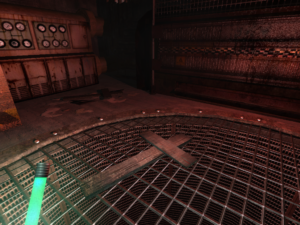Dino Crisis: Its place in the history of Survival Horror
I mentioned in my last post that I never really understood the appeal of Resident Evil. Well, Tom Bissell devotes an entire chapter of Extra Lives, his recent book on the videogaming experience, explaining it to me. The key is that I approached it from a background of playing games on computers, while Bissell is purely a console gamer. What difference does this make? First of all, it means that he had never played Alone in the Dark, and thus the the gameplay in RE seemed new and different to him. Beyond that, he writes about how the game created a sense of unease by subverting the console gamer’s expectations. “Plenty of games have given you spaces around which to wander”, he says, “but they always took care to provide you with a maximal vantage point. This is not a maximal angle; this is not at all how your eye has been trained by video games to work.” Or about the awkwardness of the gunplay: “Video-game armaments have always seemed to you 1In this chapter, Bissell makes the odd choice of describing his own experiences in the second person. It’s especially weird if, like me, your actual experiences with the game are completely unlike his. a kind of voodoo. If you wanted some digital effigy to die, you simply lined it up and pushed in the requisite photonic pin. Here, however, there is no crosshair or reticule.” Later, he describes the discovery that you can’t move while shooting, and describes it as violating “another convention of the form”: “In video games, you can shoot your sluggish bullets while running, jumping, falling off a cliff, swimming underwater.” These unaccustomed limitations create a sense of helplessness conducive to panic. “A ‘scary game’,” he concludes, “seems a far less laughable notion than it did only a few moments ago.”
But who said the notion was laughable? I come from text adventures; I had known ever since The Lurking Horror how interactivity could heighten a sense of fear even in cliché situations. Moreover, the awkward controls were probably less effective on the PC, because to a PC gamer, awkward controls were the norm. Even back then — especially back then — the lower barriers to entry and complete lack of enforceable standards meant that PCs were friendlier to experimentation on the part of game designers, for good and for ill.
Finally, it’s always seemed to me that RE severely undercut the horror element by making the player character part of an elite special-tactics police team, and therefore already more prepared than most to deal with a zombie uprising. To console gamers at the time, this may have been unremarkable; console games were mainly action games, which tended to have highly-trained, technologically-augmented, or even outright superhuman protagonists, to both justify how you could singlehandedly defeat scores of computer-controlled enemies and to appeal to the target audience’s power fantasies. Again, I was a fan of adventure games, which are more given to everyman heroes. But adventure games have never been big on consoles.
So, how does all this relate to Dino Crisis? For starters, it carries the highly-trained player character part even farther. You’re military this time, part of a G.I. Joe-like special-forces team, sent to extract a scientist from a secret laboratory on a remote island. The intro cutscene shows you parachuting onto the island with a kind of gee-whiz feel, clearly aimed at kind of kid who doodles tanks in his notebook. This is horror?
Well, maybe it’s not. Those subversions of expectation that Bissel described as contributing to the sense of fear? The designers of Dino Crisis seem to have generally regarded them as flaws, and removed them. This time, you can walk around with your gun drawn. Abrupt changes of camera angle still exist, but to a much lesser degree: unlike RE, DC is in a fully 3D-rendered environment, which allows the camera to move smoothly with you. The gun seems to auto-aim, or perhaps it’s just that the dinosaurs are big enough (and, whenever I encounter one, close enough) to be hard to miss. Either way, it makes the lack of aiming aids unimportant. The movement controls are still as awkward as non-camera-relative directional movement always is, but that’s as far as it goes for interfering with convention.
It’s still a blatant RE imitation, but it’s as if Capcom decided that the way forward, the way to make the genre to appeal to more people, was to play it safe and make it more like a typical console game. Meanwhile, I’m approaching it from the opposite direction, so it seems like a step backward.
| ↑1 | In this chapter, Bissell makes the odd choice of describing his own experiences in the second person. It’s especially weird if, like me, your actual experiences with the game are completely unlike his. |
|---|
 Comments(5)
Comments(5)